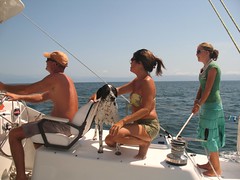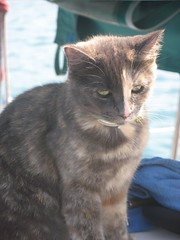A picture graces the cover of Sail Magazine of a magnificent catamaran cresting a wave, bows thrust out over the peaks looking for all the world as though the craft is about to launch itself into space. The sails are full, lines straining, and if you can see the captain and crew their faces are caught in a rictus grin of manic sailing glee. The sun is bright, the boat gleams. As a reader, you can not look at the picture without seriously contemplating purchasing one of these amazing craft. It's 35 degrees out, you're soggy and bundled to the eyebrows in a slightly skanky smelling wool coat, boarding a plane home from a meeting in Chicago. You grab the magazine, a pack of Juicy Fruit, an Odwalla, and a tired looking bagel before heading out of the shop to get in line.
It might improve your state of mind to know that approximately .05 seconds after the picture was taken, the boat slammed back to reality as it smashed bows forward into the back of the wave. Someone screamed over at the camera man, “Do you have the damn picture yet?” If the answer was in the affirmative, the crew breathed a sigh of relief, relaxed the lines a bit and fell at least ten degrees more off the wind; They might take longer to get back to the dock, but at least it won't be a miserable flipping slog. If the answer was in the negative, the crew braced themselves for another 15 minutes of loud, uncomfortable bashing into swells, wind, and a very hard ocean.
In my considered opinion, upwind sailing is romantic only in magazines. In the real world where boats actually float, gentlemen never sail to wind. While it is true that sail boats are generally designed to sail to windward, and in fact many sail considerably better and more rapidly pointed into the teeth of the gale, it is rarely a comfortable ride. In truth, the problem is not really the wind, it is the unfortunate truism that where cometh the wind, there cometh the swell. After only an hour of steady 20 knot winds from the northwest, you can count on a seriously nasty northwest chop. The stronger and longer the winds persist, the steadier, bigger, and crestier the waves become. Ocean swell, in fact, is largely a by-product of really big, really strong, really steady winds someplace out in the middle of the ocean which like ripples in a global pond just radiate out out out out until they roll you in an anchorage on the Mexican coastline during otherwise perfectly calm and windless night.
Just to make life entertaining out here, swell often comes from one direction – let's say a pineapple express from the southwest – while wind waves emerge from a norther. So now we're looking at a 2 foot swell every 7 seconds from your stern port side and a 4 foot wave every 3 seconds from your bow port, 15 knots on the bow port, and a helm woman in a very bad temper. The kids are just queasy enough even after a year at sea to be rendered incapable of geometry and history, while the captain is puzzling over the latest cause for coolant loss in the refrigerator.
We call it “the bash.” The bash is not a party. The bash is precisely what the boat does every few seconds for hours on end as you push your way north. This same coastline southbound in precisely the same conditions is a gentle roller coaster ride, water sluicing down the sides of the boat with an occasional swell thumping playfully on the bridge deck. Current, wind, and the fine performance of a cat in light winds ensure a quick passage with speeds averaging seven or eight knots an hour even in our dog slow condomaran. Upwind, however, is an entirely different story. We barely average four as our poor home crashes against the wind driven waves.
The famously rocking horse motion ascribed to catamarans is strongly evident... no heeled slicing of bow through waves for us. We rock up, push our bows into open air, then bang down. If we start to make too much speed and headway, instead of bashing down on the back of the wave, we swoop our bows directly into the face of the following wave. The girls love it when this happens as the result is a flood of water through the tramp and over the bows, wind driven spray pushing all the way into the cockpit even – when the angle is just right – drenching the helm in her cursing, exhausted splendor. Lest anyone worry about us, Don Quixote is in no danger in these seas of turning turtle. While it is true that burying bows into the face of a wave is precisely how a catamaran can flip, let's be clear that to do so requires much bigger waves, much greater wind than what Don Quixote is facing on the Mexican Riviera. Ironically, it also requires a downwind sail, which I can assure you we are not doing at present.
No, our catamaran is a really solid boat. She doesn't actually object to this type of sailing, and beats steady progress northwards with a resigned, firm approach. She takes the waves, she handles the wind, she explains in small creaks and the occasional smashed wine glass that if we're going to bash upwind, there is a price to pay.
Dulcinea is not nearly so sanguine; She'll meow whenever Don Quixote does one of those magazine worthy flying leaps into the next wave, lifting her head to reproachfully glance at me at the helm, her message obvious, “A smoother ride, please. We cats prefer a downwind sail.”



1 comment:
Hang on my dear Toast, there are calm waters to the north. Is full face protection gear required for your run north? Be safe, M&C
Post a Comment